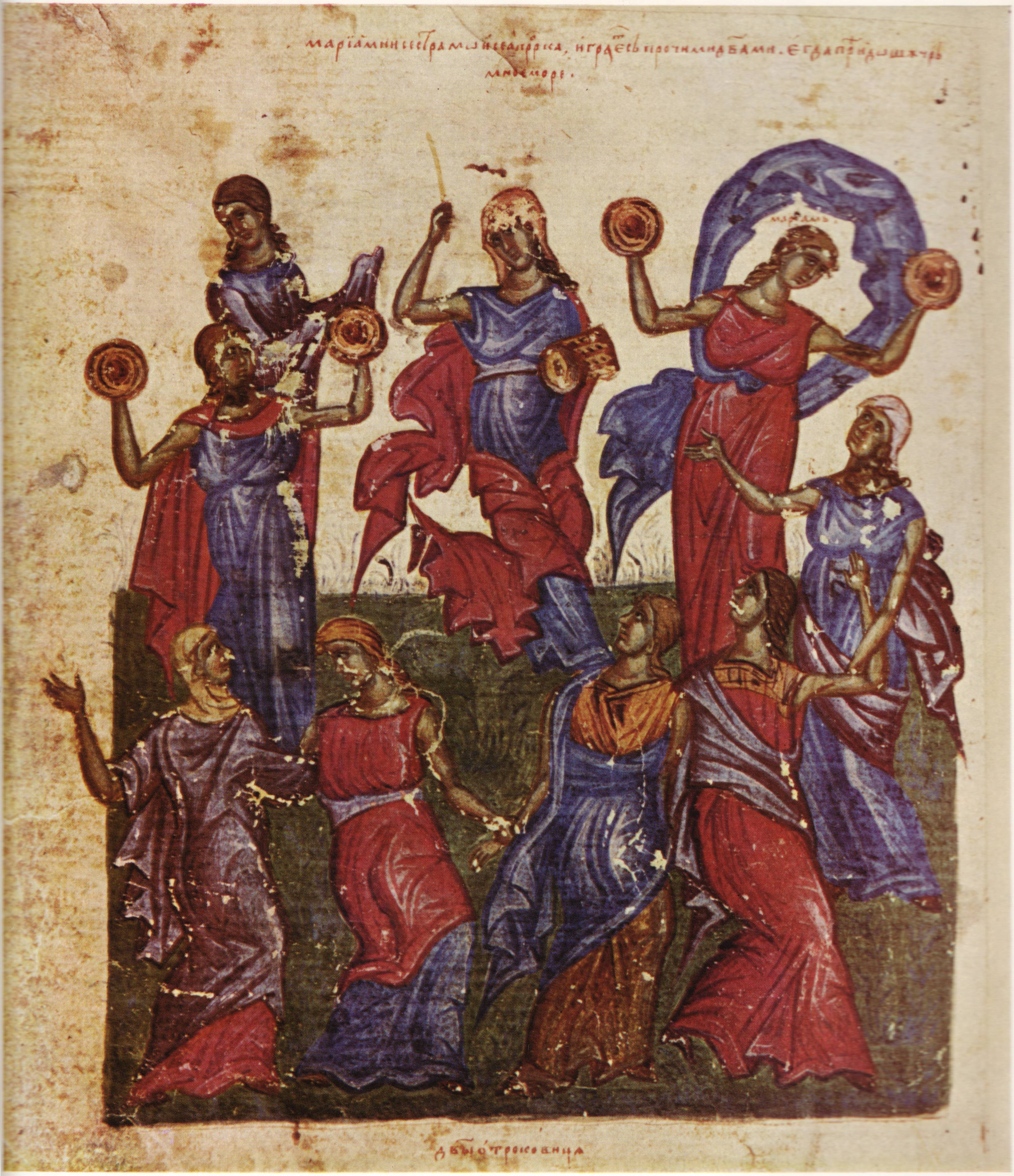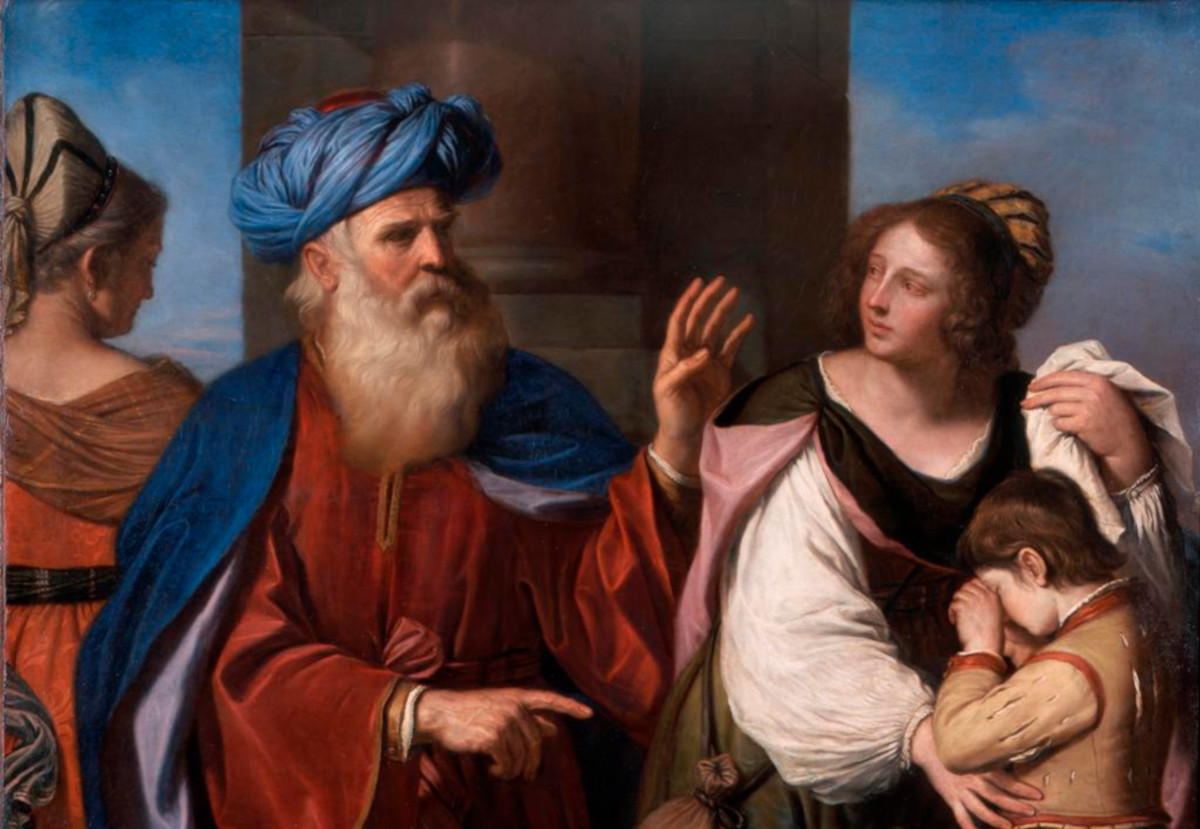Joshua 2:1-24, 6:17-25. (See also Matthew 1:5, Hebrews 11:31 & James 2:25.) Rahab’s story is told in the book of Joshua. She is a prostitute in Jericho. The spies who Joshua sent to spy out the land and the city lodge with her. The king of Jericho mounts a search for them, having heard the spies are with her. She hides them, throws the Jericho authorities off their trail, and gives them good advise on how to escape, at the same time striking a deal with them by which she and her father’s family can have their lives saved when the Israelites attack and take the city. The spies insist that anyone staying in her house during the attack will be protected, and this will be indicated by a red sash that she will hang in the window (ch 2). This all comes to pass (ch 6).
These bare narrative bones do not tell us much by which to explain the inclusion of this episode in Sacred Scripture or her wider significance in texts of faith. Is she any more than a worldly woman looking after her own self-interest and that of her nearest relatives, even at the ‘cost’ of betraying her own city and wider ethnic group? Does her ‘virtue’ lie only in reading correctly (as it turns out) the political and military situation that is unfolding and choosing to side with the side she thinks will be victorious?
It is possible that the material about her reflects an alternative account, and thus a different source, about the fall of Jericho than the miraculous, and liturgically presented dramatic version that now dominates the book of Joshua, by which, obeying divine instructions, the walls come tumbling down after Joshua’s troops have marched around the city with the Ark of the Covenant. The story involving Rahab points to an initiative by Joshua (2:1), reminiscent of the spying trip he himself had made earlier (Numbers 13), and one in which the rope from the window may well have provided troops with an easy, unresisted, entrance to the city in order to sack it. This truly would be information the spies would not want passed back to the king of Jericho. None of this helps to explain Rahab’s inclusion or significance in a sacred text, but it would explain the ongoing presence of such Canaanite groups in the land (6:25), despite the general instruction that such peoples were to be wiped out (6:17-18 and elsewhere).
If such a theory of Rahab’s active role has some merit it has been worked into the wider concerns and reflections of the book of Joshua as we now have it. These put the emphasis on the Lord’s sovereignty. As such the Lord, not Joshua, is the true leader of the conquest. Palestine belongs to the Lord and he gives it to those whom he pleases. He makes covenant with this chosen people and only such people are to inherit it, and then only if they keep the terms of the covenant, other peoples coming under divine judgement. This judgement (which need not be seen as arbitrary but one reflecting God’s awareness of human sinfulness in general) and the total destruction of such peoples that expresses it are to prevent the (re)contamination of the covenanted people of Israel. Within such a theological view, the fact of the survival of Rahab and other such groups needed explaining.
Rahab is presented as grasping this theological overview and to acting upon it. She has a profound grasp of it, though the reason for this is not given. She knows of God’s saving action at the Red Sea, and thereafter against other nations (2:10). She recognises the Lord’s power and sovereignty. Crucially she then appeals for her family in terms of a kindness to be remembered and acted on (2:12), using the term ‘hesed’ which the Bible often uses of God’s mercy, at the heart of the covenants God makes with his people. The pact she makes with the spies has a covenantal form, binding both parties to certain actions and certain penalties.

Rahab, then, is presented as a woman of faith and righteousness, one who had a true sense of God and divine power, and who chose to enter into covenant with such a God and his covenanted people. As such she had every reason to live in the land with those Israelites who kept the covenant, despite her different ethnic origins and indeed her sinful past. God has chosen her, just as God chose the Israelites. Her faith and inclusion among those who inherit the land point to divine favour, if one that has to be co-operated with, but one capable of wiping away the impact of a sinful past. Ethnicity and sin are not barriers to being chosen and blessed by God. Rahab moved from being a prostitute to being a faithful believer, believers who came to be portrayed as the spouse of their God, bound to God in covenant.
This reflection on Rahab had already taken place by the time the account of her life is written down in the book of Joshua. It is also found in the New Testament which mentions her no less than three times. One can well imagine that the close, and often transforming, relationships that Jesus had with prostitutes, may have been a stimulus for this notable inclusion of her in the seminal texts of the Church. The Letter to the Hebrews (11:31) notes her faith in receiving the spies. James (2:25) notes that her faith was real because it issued in the good deed of helping the spies escape. The other reference to Rahab is in Matthew’s Genealogy of Jesus (1:5). Though it is not extant in our records of that period, Jewish thought by the time of Jesus, aware of her high standing as a heroine of the Jewish faith, must have already included her in the genealogy of David (quite probably drawing on 1 Chronicles 4 & 5). Mathew could not have made a persuasive argument from her if he had originated the idea. Matthew’s point is to see in Rahab something of the situation of Mary. Both share faith, issuing in good deeds, and are persons who take the initiative, over and above their peers, in co-operating with God. Rahab did this despite her sexual past and was still part of the line that led to the Messiah. Matthew is most probably offering assurance to anyone worried about the timing of the pregnancy of Mary, beginning as it did before she came to live with Joseph, that this ought not disturb their faith, let alone destroy it. The Jews had learned not to be scandalised by Rahab and Christians ought not to be scandalised by when God acted to bring about the Incarnation in Mary.

Therefore, Rahab, despite the brief incident in which she features, is a very important figure for our own faith. We should not overlook the relatively brief reference to her. Nor should we be dismissive of prostitutes or others in sexually irregular situations. We often do not know the circumstances that led to their situation and should avoid judging them as persons. It is often abuse and other hardships in life that leads to such lifestyles. God knows the hearts of all, and is able to stir up a response to grace, and one that saves. He did it with Rahab, he did it through the ministry of Jesus, he did it in the lives of many saints, and he seeks to do it again in our day. Are we open to this? Nor should we despair of our own sexual tensions and difficulties: God loves us in the totality of who we are, and can work with all of who we are, transforming it, to God’s greater glory and serving his purposes. Like Rahab, let us have faith in the mercy of God and act in such ways that this may be a blessing to others.
 We are told relatively little about Deborah in the Old Testament. However, the little we do learn comes to life when we see Deborah in context, as part of a broader picture of God guiding and teaching his people. The book of Judges begins with two prologues. The first is more historical in tone and gives an account of the conquest of the Promised Land after the death of Joshua. In broad brush-strokes it summarises how the twelve tribes, strengthened by God, claimed one victory after another over the local Canaanite tribes. However, rather than dispossessing these conquered peoples as the Lord commanded, Israel instead enslaved her neighbours and subjected them to forced labour. For this disobedience, Judges tells us, God withdraw his support for Israel's armies. Instead, the nations became Israel's "oppressors" and their gods "snares" (Judges 2:1-5).
We are told relatively little about Deborah in the Old Testament. However, the little we do learn comes to life when we see Deborah in context, as part of a broader picture of God guiding and teaching his people. The book of Judges begins with two prologues. The first is more historical in tone and gives an account of the conquest of the Promised Land after the death of Joshua. In broad brush-strokes it summarises how the twelve tribes, strengthened by God, claimed one victory after another over the local Canaanite tribes. However, rather than dispossessing these conquered peoples as the Lord commanded, Israel instead enslaved her neighbours and subjected them to forced labour. For this disobedience, Judges tells us, God withdraw his support for Israel's armies. Instead, the nations became Israel's "oppressors" and their gods "snares" (Judges 2:1-5).











.JPG)

.JPG)
.JPG)
.JPG)









